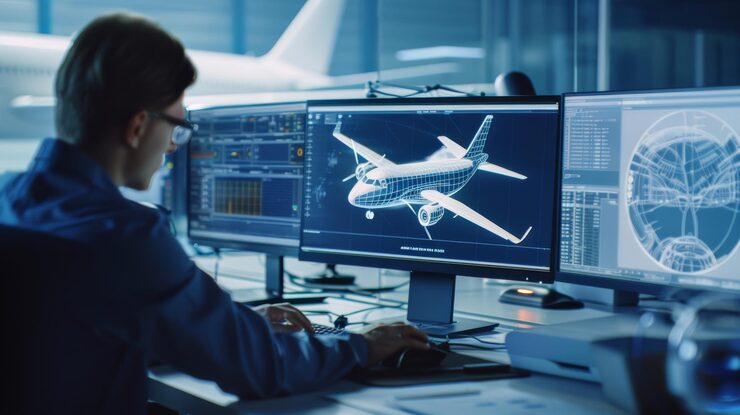The aviation industry thrives on precision, performance, and innovation. Every successful mission or aircraft relies heavily on the accuracy and reliability of its software and testing frameworks. The development of flight software is at the core of ensuring that modern aircraft and aerospace systems operate flawlessly. Whether it’s simulation, data analysis, or real-world testing, these technologies form the foundation of advanced aerospace solutions. In this article, we’ll explore how Flight Level Engineering combines expertise, testing, and innovation to deliver exceptional aerospace results that redefine safety and performance.
Understanding the Importance of Flight Software
Flight software acts as the brain of every aerospace system. It controls how aircraft respond to different conditions, manage data, and communicate with other onboard systems. From navigation and control to mission management and telemetry, the precision of this software determines flight success. In aerospace engineering, even the smallest code malfunction can impact mission safety. Therefore, the development process involves strict testing, validation, and verification procedures to ensure that every component functions reliably across diverse environments.
Core Elements of Aerospace Software Development
Creating software for flight systems requires a multidisciplinary approach. Engineers integrate programming, control theory, and real-world flight dynamics to produce reliable outcomes. The main components include:
- Real-time performance: Software must react instantly to flight commands.
- Redundancy: Systems are designed to handle failures through multiple layers of protection.
- Certification compliance: Aerospace software must adhere to industry standards such as DO-178C for safety.
- Modular design: Ensures flexibility and easier updates for future missions.
These principles ensure that aerospace systems remain dependable and efficient even under the most demanding conditions.
flight software
The Role of System Integration in Modern Aerospace
System integration links software, hardware, and flight mechanisms into a cohesive operation. It ensures that sensors, actuators, and avionics components function seamlessly together. Engineers test how systems behave in simulated and real-world environments, verifying that they communicate and respond accurately. Proper integration reduces risks, enhances performance, and enables precise control during flight. By combining advanced programming with practical testing, Flight Level Engineering delivers integrated solutions that meet complex aerospace requirements.
Simulation and Testing for Risk Reduction
Before any aerospace system takes flight, engineers use advanced simulation and testing tools to predict and refine performance. Simulations recreate real flight conditions, allowing engineers to assess system reactions without physical risks. Hardware-in-the-loop (HIL) and software-in-the-loop (SIL) testing help verify communication between different subsystems. By using simulation early in the process, costly design flaws can be identified before full-scale implementation, saving both time and resources.
Precision Through Flight Testing
Real-world testing marks a crucial step in aerospace development. Here, a flight test engineer ensures that every component performs as expected under actual flight conditions. These engineers plan, execute, and analyze test flights to gather data on system stability, performance, and safety. Their expertise bridges theoretical design and real-world performance, confirming that software and hardware integration operates seamlessly. Detailed data collected during flight tests helps refine systems for maximum efficiency and reliability, ensuring that final products meet aerospace safety standards.
Data Acquisition and Analysis
Accurate data is the cornerstone of aerospace advancement. Engineers collect telemetry and sensor data during both simulations and test flights to evaluate system performance. This data is then analyzed to identify potential issues, optimize algorithms, and ensure consistent functionality. With precise data management, engineers can predict and prevent failures before they occur. The insights gained from this analysis support continuous system improvement and innovation.
The Impact of Collaboration Across Disciplines
Aerospace engineering requires collaboration among specialists in software, electronics, mechanics, and testing. This cross-disciplinary teamwork ensures that each part of the project aligns perfectly with the others. When flight software developers and test engineers work together, projects move faster and more accurately. The collaborative model used by Flight Level Engineering encourages open communication and shared goals, leading to efficient solutions and reliable outcomes for clients across aviation and defense industries.
Tailored Solutions for Diverse Aerospace Projects
Every aerospace project has unique technical and operational demands. Flight Level Engineering provides custom-tailored services that meet the needs of startups developing new flight systems and established companies enhancing existing platforms. The firm’s services span software development, simulation, hardware integration, and real-world flight validation. This flexible approach ensures that each client receives solutions that fit their mission objectives, timelines, and budgets without compromising quality or safety.
Benefits of Engineering Precision in Aerospace
The advantages of precise aerospace engineering go beyond performance. Key benefits include:
- Enhanced reliability: Systems perform consistently under various conditions.
- Safety assurance: Rigorous testing reduces operational risks.
- Reduced cost and time: Early-stage simulations and testing streamline development.
- Innovation potential: Engineers can focus on designing future-ready systems.
- Regulatory confidence: Projects meet strict aviation standards, ensuring compliance and trust.
These outcomes make flight software and engineering excellence critical for organizations aiming to achieve long-term aerospace success.flight software
Real-World Applications and Industry Examples
The principles of flight software development and testing are applied across a wide range of aerospace sectors. From unmanned aerial vehicles (UAVs) to commercial and defense aircraft, these systems ensure accuracy, control, and efficiency. For instance, in unmanned systems, reliable communication between onboard sensors and control centers is essential for mission safety. Similarly, in defense applications, adaptive flight control software provides stability and performance under high-stress scenarios. Flight Level Engineering has contributed to these areas by developing robust systems that meet both innovation and safety demands.
Conclusion
In today’s advanced aerospace landscape, flight software and system engineering define the future of aviation. From code design and integration to testing and analysis, every stage plays a vital role in achieving flight precision. The collaboration between engineers, data analysts, and testers ensures that aerospace systems operate safely and efficiently. Flight Level Engineering stands as a trusted partner, driving innovation through expertise and dedication. Some line brief – flight level engineering.





